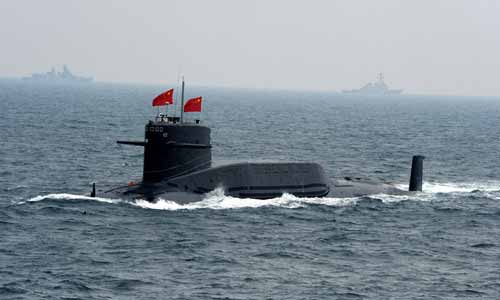China prepares to deploy nuclear submarines at Pakistan’s Gwadar Port, worry Indian security establishment
 NEW DELHI : In a development which is likely to worry Indian security establishment. China is planning to deploy nuclear submarines at Gwadar Port in Baluchistan province of Pakistan to keep a close tab of Indian Navy.
NEW DELHI : In a development which is likely to worry Indian security establishment. China is planning to deploy nuclear submarines at Gwadar Port in Baluchistan province of Pakistan to keep a close tab of Indian Navy.
This vindicates India’s long-standing discomfort over the possibility that the true purpose of China’s involvement in Gwadar is strategic more than trade.Gwadar Port, which China has financed and built, would give Beijing the direct strategic access and to the Indian Ocean Region (IOR) that it has always craved, and give it blue water naval capability.
The stationing of a submarine fleet there would also allow China to keep close tabs on the operations and influence of the Indian Navy.It is learnt that a high-level delegation of Chinese officials recently visited Islamabad and held meeting with key figures in the Pakistan Navy, to expedite the nuclear submarines base projects.
Recently, a high level delegation from China visited Islamabad and held meeting with senior Pak Naval officers to expedite the entire project. PLA is eager to operationalise Nuclear Submarines Bases earliest, a clear sign of their aggressive intent. China has invested extensively in rebuilding Gwadar port as part of their BRI initiative. It is clear now it wants to use the port as a strategic asset to keep surveillance on Indian Navy.
China is looking to deploy nuclear submarines which are capable of carrying nuclear reactors onboard. It can be stationed at sea for an extended period of time. As per Naval Intelligence
Report, PLA submarines have been seen operating in Indian Ocean Region (IOR)and now PLA nuclear submarines are expected to be deployed in IOR for prolonged duration as Oceanic Transition Route (OTR) facility would be available at Gwadar and Djibouti.
Pakistan Navy is constructing Very low frequency (VLF) Station for strategic submarines communication.China is executing the project in liaison with Pakistan Navy. The civil works related to construction of 205 antenna tower foundation,underground VLF building and Power Station is currently going on. VLF provides one way communication to submarines operating into deep water.
Pakistan navy is also activating Forward Operating Bases ( FOB) AT Gwadar with the help of Chinese companies. These bases would provide maintenance and repair facilities to Pakistan Navy and nuclear submarines deployed by PLA.
The Pakistani Navy is constructing a VLF station for strategic submarine communications. VLF, or Very Low Frequency, stations enable one-way communications with submarines operating in deep sea. Submarine communications tend to be one-way most of the time, because a submarine that doesn’t transmit is extremely difficult to detect.
China is working with the Pakistani Navy on the civil works. Work has already begun on the foundation for a 205-foot antenna tower, underground VLF building and power station, which would allow repair, maintenance and other logistics work to be carried out on Chinese and Pakistani Navy ships.
Indian military intelligence agencies have already reported instances of Chinese submarines hanging around close to the Indian
(With Agency Inputs ).coast.
China also recently operationalised a military base in Djibouti, on the coast of the African mainland, at the entry to the crucial Bab-el-Mandeb Strait to the Red Sea.
ooooooo
China has already begun work on infrastructure required to station nuclear submarines at the Gwadar Port in southwestern Pakistan. This vindicates India’s long-standing discomfort over the possibility that the true purpose of China’s involvement in Gwadar is strategic more than trade.
Gwadar Port, which China has financed and built, would give Beijing the direct strategic access and to the Indian Ocean Region (IOR) that it has always craved, and give it blue water naval capability. The stationing of a submarine fleet there would also allow China to keep close tabs on the operations and influence of the Indian Navy.
Nuclear submarines are called so only because they are powered by a nuclear reactor onboard. They do not necessarily carry nuclear weapons. Nuclear submarines can remain at sea for extended periods of time since they do not need to keep returning to land for fuel.
It is learnt that a high-level delegation of Chinese officials recently visited Islamabad and held meeting with key figures in the Pakistan Navy, to expedite the nuclear submarines base projects. China is eager to have three submarine bases operationalised on the southern Pakistan coast.
Beijing had recently denied speculation that it was setting up a harbour in Jiwani Port, close to the Iran border. This harbour was meant exclusively for Chinese warships, with Gwadar being portrayed as a trade hub.
The Pakistani Navy is constructing a VLF station for strategic submarine communications. VLF, or Very Low Frequency, stations enable one-way communications with submarines operating in deep sea. Submarine communications tend to be one-way most of the time, because a submarine that doesn’t transmit is extremely difficult to detect.
China is working with the Pakistani Navy on the civil works. Work has already begun on the foundation for a 205-foot antenna tower, underground VLF building and power station. Work has also begun on activating Forward Operating Bases, which would allow repair, maintenance and other logistics work to be carried out on Chinese and Pakistani Navy ships.
Indian military intelligence agencies have already reported instances of Chinese submarines hanging around close to the Indian coast.China also recently operationalised a military base in Djibouti, on the coast of the African mainland, at the entry to the crucial Bab-el-Mandeb Strait to the Red Sea.(With Agency Inputs ).

